tow TOYOTA SEQUOIA 2022 User Guide
[x] Cancel search | Manufacturer: TOYOTA, Model Year: 2022, Model line: SEQUOIA, Model: TOYOTA SEQUOIA 2022Pages: 592, PDF Size: 10.82 MB
Page 141 of 592
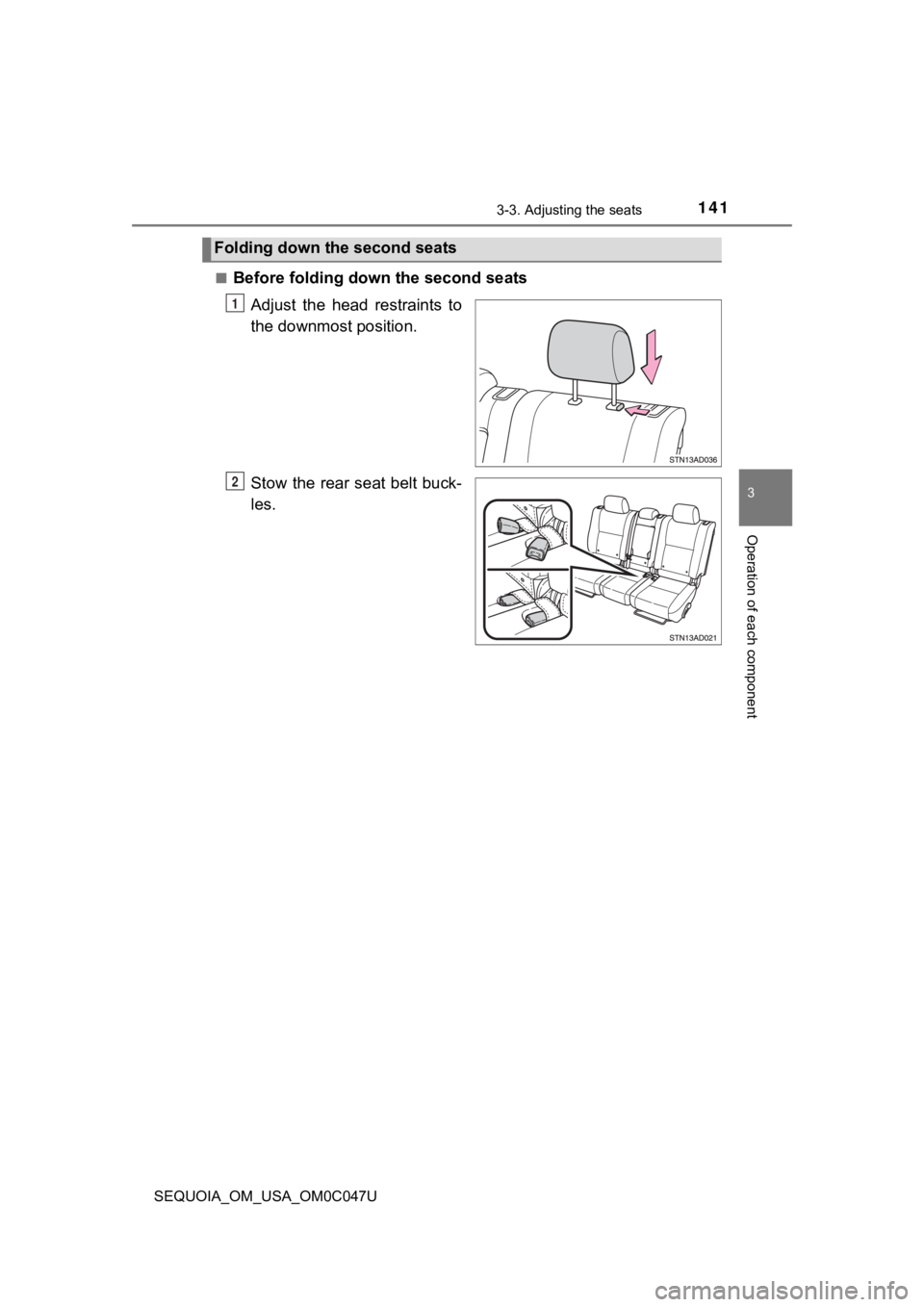
1413-3. Adjusting the seats
3
Operation of each component
SEQUOIA_OM_USA_OM0C047U■
Before folding dow
n the second seats
Adjust the head restraints to
the downmost position.
Stow the rear seat belt buck-
les.
Folding down the second seats
1
2
Page 144 of 592
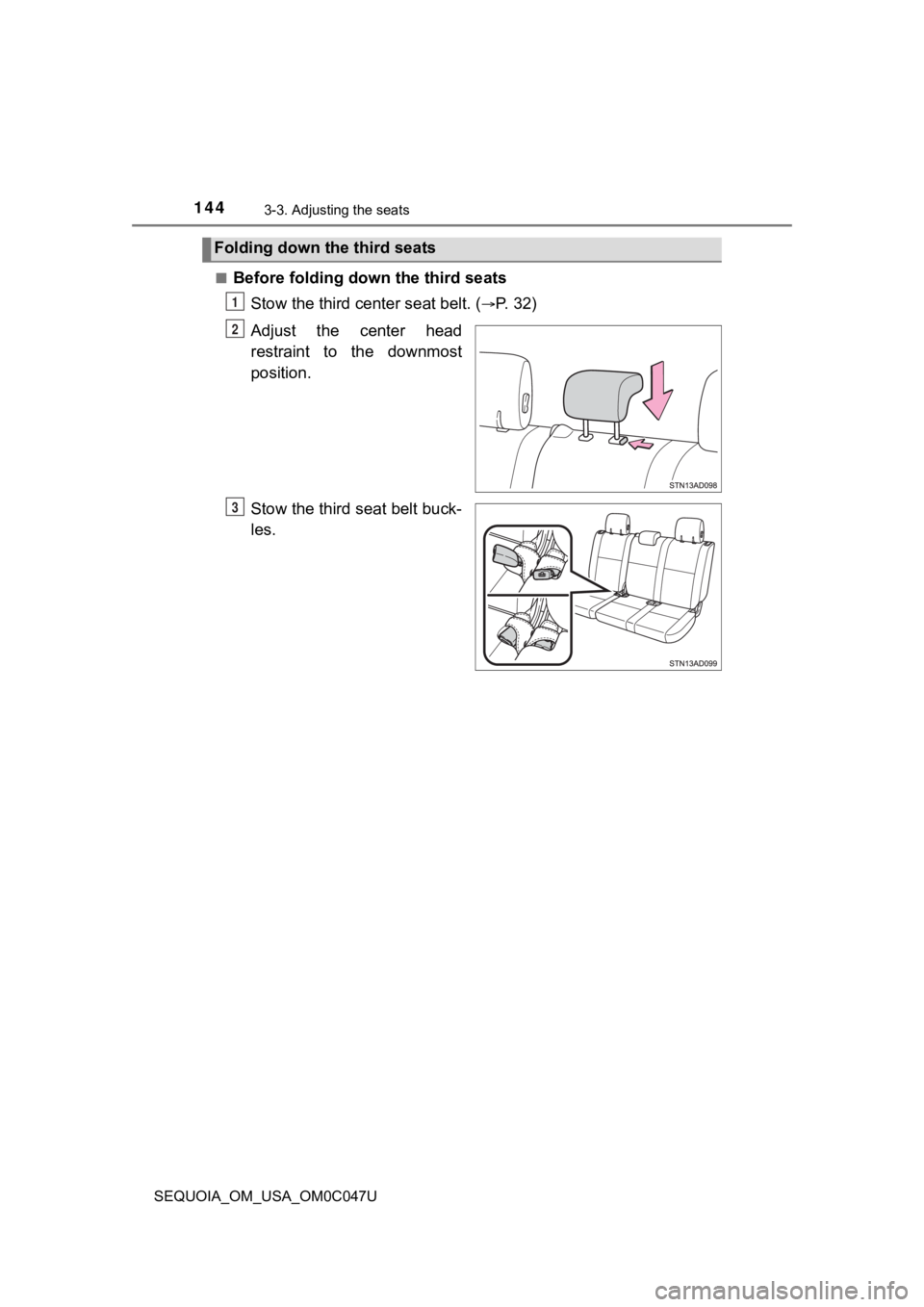
1443-3. Adjusting the seats
SEQUOIA_OM_USA_OM0C047U■
Before folding down the third seats
Stow the third center seat belt. (
P. 3 2 )
Adjust the center head
restraint to the downmost
position.
Stow the third seat belt buck-
les.
Folding down the third seats
1
2
3
Page 148 of 592

1483-3. Adjusting the seats
SEQUOIA_OM_USA_OM0C047U
NOTICE
■Stowing the seat belts
The seat belts and the buckles must be stowed.
■ Second seatback board weight capacity (if equipped)
Do not place any object heavier than 220 lb. (100 kg) on the se cond seat-
back board.
■ Before sliding the second center seat to the most forward posit ion
(vehicles with bench type second seat)
Ensure that the cup holder on the front console box is closed.
Page 155 of 592
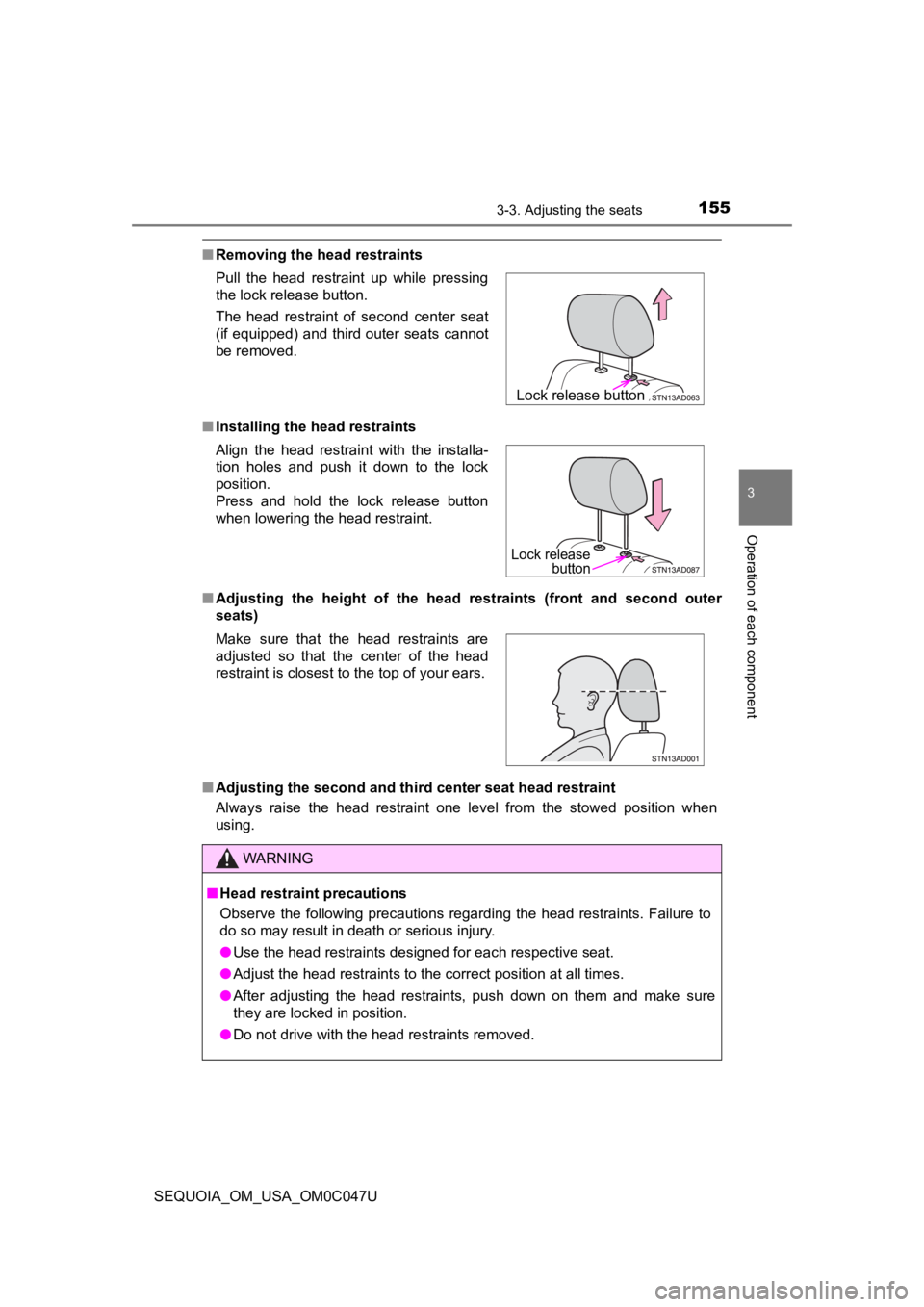
1553-3. Adjusting the seats
3
Operation of each component
SEQUOIA_OM_USA_OM0C047U
■Removing the head restraints
■ Installing the head restraints
■ Adjusting the height of the head restraints (front and second o uter
seats)
■ Adjusting the second and thir d center seat head restraint
Always raise the head restraint one level from the stowed position when
using. Pull the head restraint up while pressing
the lock release button.
The head restraint of second center seat
(if equipped) and third outer seats cannot
be removed.
Align the head restraint with the installa-
tion holes and push it down to the lock
position.
Press and hold the lock release button
when lowering the head restraint.
Make sure that the head restraints are
adjusted so that the center of the head
restraint is closest to the top of your ears.
WARNING
■ Head restraint precautions
Observe the following precautions regarding the head restraints. Failure to
do so may result in death or serious injury.
● Use the head restraints designed for each respective seat.
● Adjust the head restraints to the correct position at all times.
● After adjusting the head restraints, push down on them and make sure
they are locked in position.
● Do not drive with the head restraints removed.
Lock release button
Lock releasebutton
Page 156 of 592
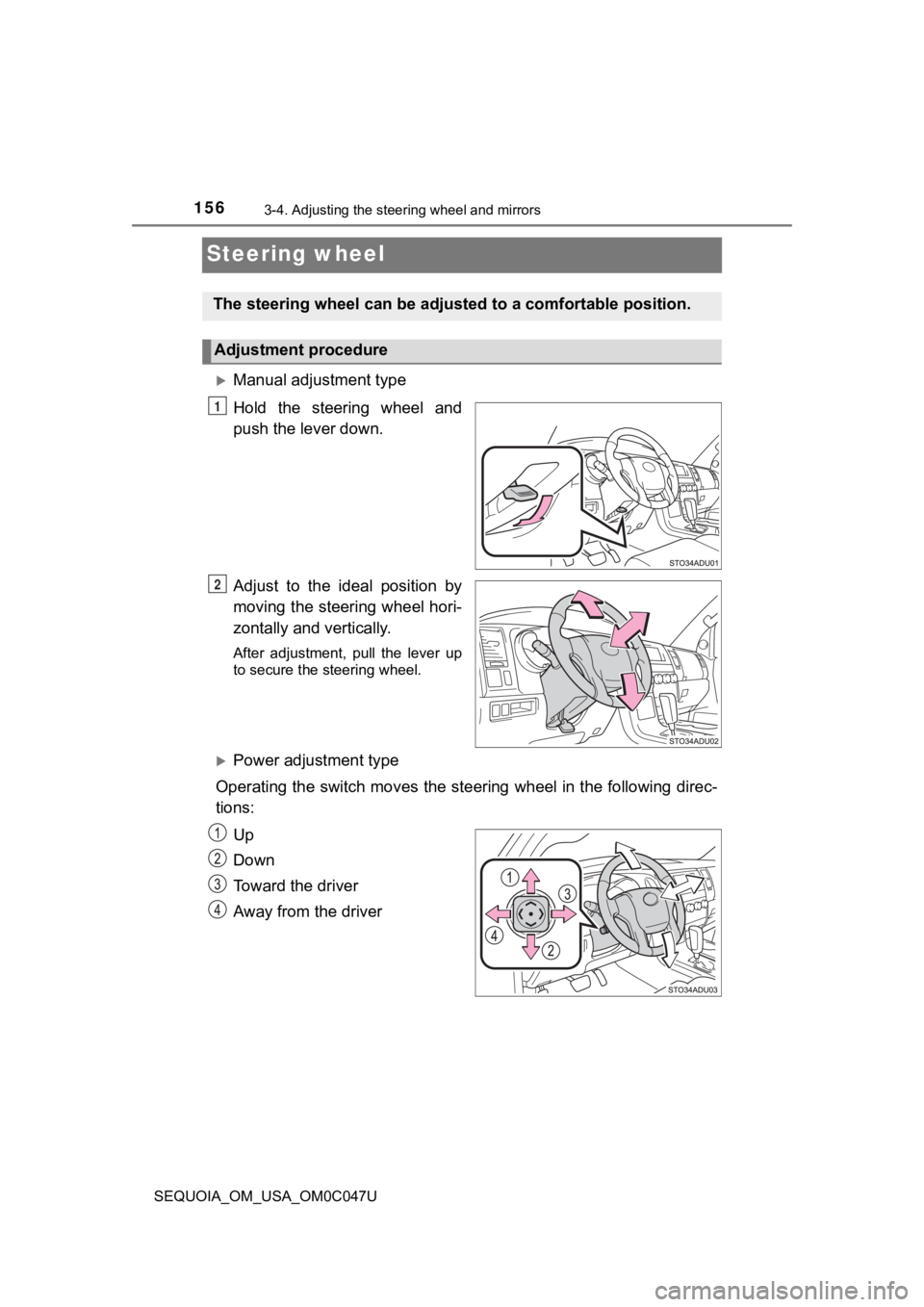
1563-4. Adjusting the steering wheel and mirrors
SEQUOIA_OM_USA_OM0C047U
Steering wheel
Manual adjustment type
Hold the steering wheel and
push the lever down.
Adjust to the ideal position by
moving the steering wheel hori-
zontally and vertically.
After adjustment, pull the lever up
to secure the steering wheel.
Power adjustment type
Operating the switch moves the steering wheel in the following direc-
tions:
Up
Down
Toward the driver
Away from the driver
The steering wheel ca n be adjusted to a comfortable position.
Adjustment procedure
1
2
Page 162 of 592
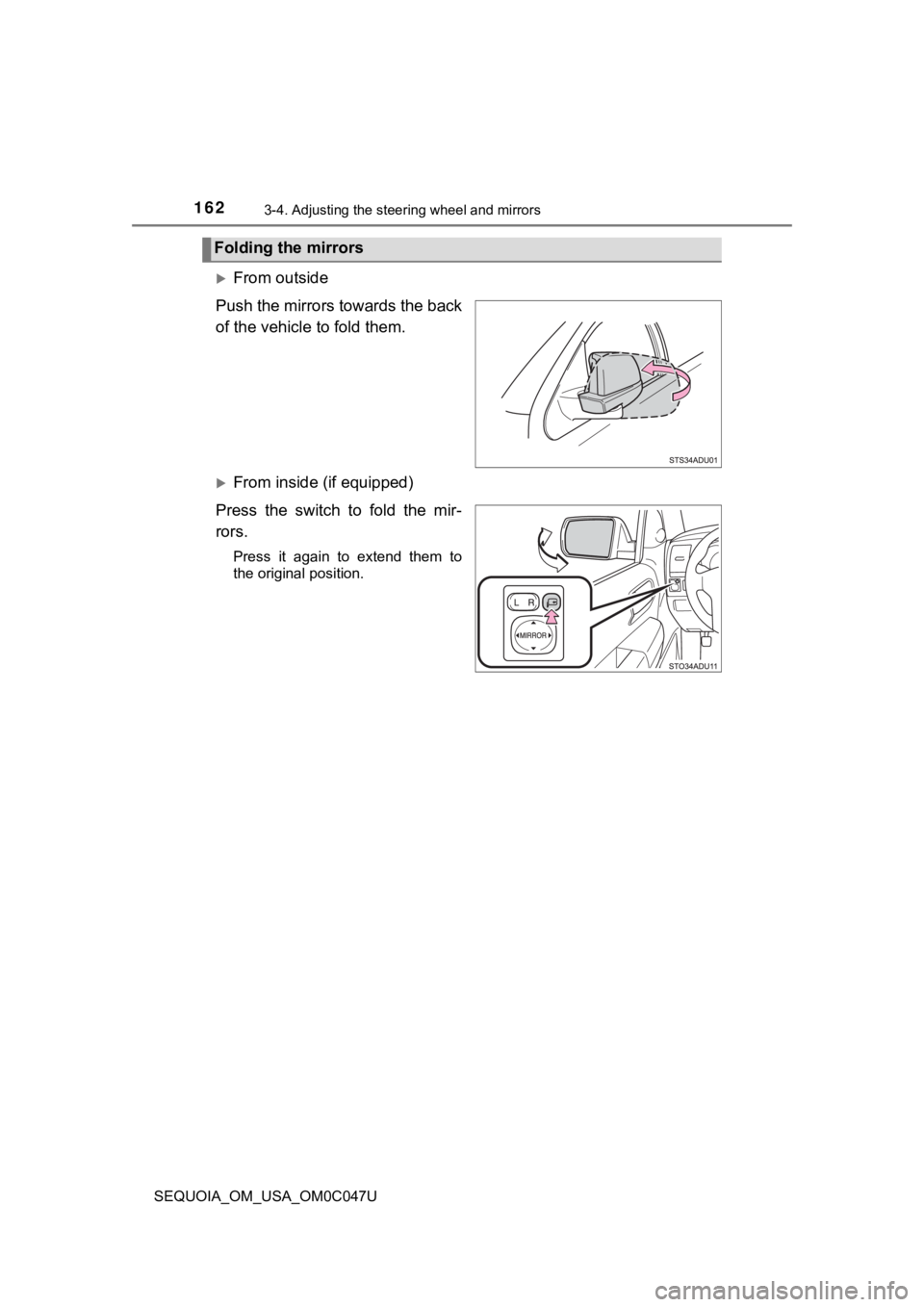
1623-4. Adjusting the steering wheel and mirrors
SEQUOIA_OM_USA_OM0C047U
From outside
Push the mirrors towards the back
of the vehicle to fold them.
From inside (if equipped)
Press the switch to fold the mir-
rors.
Press it again to extend them to
the original position.
Folding the mirrors
Page 175 of 592

175
Driving4
SEQUOIA_OM_USA_OM0C047U4-1. Before driving
Driving the vehicle ............. 176
Cargo and luggage ........... 187
Vehicle load limits ............. 193
Trailer towing..................... 194
Dinghy towing ................... 213
4-2. Driving procedures Engine (ignition) switch ..... 214
Automatic transmission ..... 220
Turn signal lever................ 225
Parking brake .................... 226
4-3. Operating the lights and wipers
Headlight switch ................ 227
Automatic High Beam ....... 231
Fog light switch ................. 236
Windshield wipers and washer ............................ 238
Rear window wiper and washer ............................ 241 4-4. Refueling
Opening the fuel tank cap .................................. 244
4-5. Using the driving support systems
Toyota Safety Sense P ..... 247
PCS (Pre-Collision System) .... 255
LDA (Lane Departure Alert) .... 268
Dynamic radar cruise control .................. 276
Intuitive parking assist....... 290
BSM (Blind Spot Monitor) ........ 297
• BSM function ................ 302
• RCTA function .............. 305
Electronically modulated air suspension ................. 311
AVS (Adaptive Variable Suspension System) ....... 316
Four-wheel drive system ............................ 317
AUTO LSD system............ 322
Driving assist systems ...... 324
4-6. Driving tips Off-road precautions ......... 331
Winter driving tips ............. 336
Page 178 of 592

1784-1. Before driving
SEQUOIA_OM_USA_OM0C047U■
Breaking in your new Toyota
To extend the life of the vehicle, observing the following prec autions is recom-
mended:
● For the first 200 miles (300 km):
Avoid sudden stops.
● For the first 500 miles (800 km):
Do not tow a trailer.
● For the first 1000 miles (1600 km):
• Do not drive at extremely high speeds.
• Avoid sudden acceleration.
• Do not drive continuously in low gears.
• Do not drive at a constant speed for extended periods.
■ Drum-in-disc type parking brake system
Your vehicle has a drum-in-disc type parking brake system. This type of brake
system needs bedding-down of the brake shoes periodically or wh enever the
parking brake shoes and/or drum are replaced. Have your Toyota dealer per-
form the bedding down operation.
■ Operating your vehicle in a foreign country
Comply with the relevant vehicle registration laws and confirm the availability
of the correct fuel. ( P. 533)
Page 188 of 592

1884-1. Before driving
SEQUOIA_OM_USA_OM0C047U
Cargo capacity depends on the total weight of the occupants.
(Cargo capacity) = (Total load capacity) — (Total weight of occ upants)
Capacity and distribution
Steps for Determining Correct Load Limit —
(1) Locate the statement “The c ombined weight of occupants and
cargo should never exceed XXX kg or XXX lbs.” on your vehicle’s
placard.
(2) Determine the combined weight of the driver and passengers t hat
will be riding in your vehicle.
(3) Subtract the combined weight of the driver and passengers fr om
XXX kg or XXX lbs.
(4) The resulting figure equals th e available amount of cargo and lug-
gage load capacity.
For example, if the “XXX” amount equals 1400 lbs. and there wil l
be five 150 lb passengers in your vehicle, the amount of available
cargo and luggage load capacity is 650 lbs. (1400 750 (5 150) =
650 lbs.)
(5) Determine the combined weight of luggage and cargo being loa ded
on the vehicle. That weight may n ot safely exceed the available
cargo and luggage load capacity calculated in Step 4.
(6) If your vehicle will be towing a trailer, load from your tra iler will be
transferred to your vehicle. Consult this manual to determine h ow
this reduces the available cargo and luggage load capacity of y our
vehicle. (
P. 193)
Page 190 of 592

1904-1. Before driving
SEQUOIA_OM_USA_OM0C047U
WARNING
■Things that must not be carried in the luggage compartment
The following things may cause a fire if loaded in the luggage compart-
ment:
●Receptacles containing gasoline
●Aerosol cans
■Storage precautions
Observe the following precautions.
Failure to do so may prevent the pedals from being depressed pr operly,
may block the driver’s vision, or may result in items hitting t he driver or
passengers, possibly causing an accident.
●Stow cargo and luggage in the luggage compartment whenever poss i-
ble.
●Do not stack cargo and luggage in the luggage compartment highe r
than the seatbacks.
●Do not place cargo or luggage in or on the following locations.
• At the feet of the driver
• On the front passenger or rea r seats (when stacking items)
• On the instrument panel
• On the dashboard
●Secure all items in the occupant compartment.
●When you fold down the rear seats, long items should not be pla ced
directly behind the front seats.
●Never allow anyone to ride in the luggage compartment. It is no t
designed for passengers. They should ride in their seats with their seat
belts properly fastened. Otherwise, they are much more likely t o suffer
death or serious bodily injury, in the event of sudden braking, sudden
swerving or an accident.